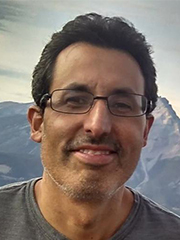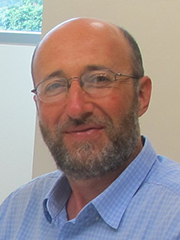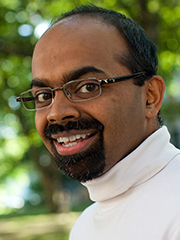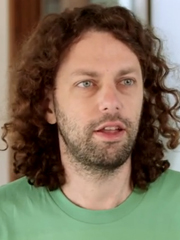Thousands of scientists working at the interface of the mathematical and biological sciences have participated in programs at the Mathematical Biosciences Institute (MBI), where they have found out about the latest advances in their fields. MBI has expanded its program with the MBI Online Colloquium. Now in its second year, this series is available as an online interactive event and as on-demand streaming. The colloquia will cover the many fields of mathematical biology. The goal of this program is twofold: to enable large numbers of researchers to hear about recent advances in the field, and to connect the mathematical biology community worldwide.
The MBI Online Colloquium gives individuals and groups the opportunity to hear from outstanding mathematical biologists and to be an active part of colloquium discussions. You can interact with leading researchers and key opinion leaders from your classroom to the comfort of your own office. If you are unable to make a talk, you can view it on-demand at a later date.
Current Season

September 25, 2019
Rafael Irizarry
Professor and Chair, Department of Data Sciences, Dana-Farber Cancer Institute; Professor of Applied Statistics, Harvard University
The Important and Extensive Role of Applied Statistics in the Biological Sciences and Beyond
Statistics has been at the center of many exciting accomplishments of the 21st century, with applied statistics being widely used across several industries and by policy makers. In academia, the number of statisticians becoming leaders in other fields like environmental sciences, human genetics, genomics, and social sciences continues to grow. The unprecedented advances in digital technology during the second half of the 20th century has produced a measurement revolution that is transforming the world. Many areas of science are now being driven by new measurement technologies and many insights are being made by discovery-driven, as opposed to hypothesis-driven, experiments. The current scientific era is defined by its dependence on data and the statistical methods and concepts developed during the 20th century provide an incomparable toolbox to help tackle current challenges. In this talk I will give several specific example including some from own research in genomics and estimating the effects of Hurricane María in Puerto Rico.

October 16, 2019
Alex Mogilner
Professor of Mathematics and Biology, Courant Institute and Department of Biology, New York University
Feedbacks Between Mechanics, Geometry and Polarity Sorting Ensures Non-Random, Rapid and Precise Mitotic Spindle Assembly
One of the most fundamental cell biological events is assembly of the mitotic spindle - molecular machine that segregates sister chromatids into two daughter cells in the process of cell division. Two existent models of the mitotic spindle assembly are 1) search-and-capture (SAC) and 2) acentrosomal microtubule assembly (AMA). SAC model is pleasingly simple: microtubules (MTs), organized into two asters focused at two centrosomes, undergo dynamic instability: they grow and shrink randomly, rapidly and repeatedly. As soon as a growing MT end bumps into a kinetochore (KT) - molecular complex in the middle of a sister chromatid – the connection between the spindle pole (centrosome) and this chromatid is established. This model predicts that KTs are captured at random times and that slow spindle assembly is plagued by errors.
For decades, the SAC model seemed to work. Recently, 'inconvenient' data ruined the SAC model and suggested that a hybrid between SAC and AMA models (the latter posits that KT-associated MT bundles get integrated with centrosomal asters at random times) could work. I will explain how we used 3D tracking of centrosomes and KTs in animal cells to develop a computational agent-based model, which explains the remarkable speed and precision of the almost deterministic process of the spindle assembly emerging from random and imprecise molecular events.

November 13, 2019
Carolyn R. Cho
PPDM-Pharmacometrics, Merck & Co., Kenilworth NJ
(Mathematical) Model-Informed Drug Development
Mathematical biosciences research is increasingly used to drive decisions that are made during the drug discovery and development process. Underscoring this impact, the U.S. Food and Drug Administration has a goal of integrating model-informed drug development (MIDD) into more drug applications and advancing the use of MIDD, under the 2017 Prescription Drug User Fee Amendments act. This goal aims to develop information that cannot or would not be generated experimentally.
We will discuss the typical scientific questions encountered during the development of therapeutic agents. To illustrate the breadth of mathematical approaches that can be employed to address these questions, the mathematical models used during the development of a novel glucose-responsive insulin will be presented.

January 22, 2020
Alison Etheridge
Professor of Probability, Department of Statistics, University of Oxford; Fellow of the Royal Society (FRS), OBE
Modelling Genes: the Backwards and Forwards of Mathematical Population Genetics
How can we explain the patterns of genetic variation in the world around us? The genetic composition of a population can be changed by natural selection, mutation, mating, and other genetic, ecological and evolutionary mechanisms. How do they interact with one another, and what was their relative importance in shaping the patterns that we see today? This question lies at the heart of theoretical population genetics.
Whereas the pioneers of the field could only observe genetic variation indirectly, by looking at traits of individuals in a population, researchers today have direct access to DNA sequences, but making sense of this wealth of data presents a major scientific challenge and mathematical models play a decisive role.
In this lecture we'll discuss how to distill our understanding into workable models and then briefly explore the remarkable power of our simple mathematical caricatures.

February 19, 2020
L. Mahadevan
Lola England de Valpine Professor of Applied Mathematics, of Organismic and Evolutionary Biology, and of Physics, Harvard University
Morphogenesis: Geometry, Physics and Biology
The diversity of living form led Darwin to exclaim that "it is enough to drive the sanest man mad". 150 years later, how far have we come in quantifying this variety? Motivated by biological observations of tissue organization in plants and animals, I will show how a combination of biological and physical experiments, mathematical models and computations allow us to begin unraveling the physical basis for morphogenesis in the context of examples such as leaves and flowers, as well as guts and brains. I will show how these pan-disciplinary problems enrich their roots, creating new questions in mathematics, physics and biology.

March 25, 2020
Mason Porter
Professor, Department of Mathematics, UCLA
Spatial Systems and Topological Data Analysis
From the venation patterns of leaves to spider webs, roads in cities, and social networks, the structure of many systems are influenced significantly by space. Accordingly, the analysis of the effects ofspace on structure and function is an active area in the study of networks and other complex systems. In this talk, I'll give an introduction to spatial networks, topological data analysis (TDA), and the application of TDA to spatial complex systems. As an illustrative example, I will present a case study using (rich, publicly-available) apocalyptic voting data from California in 2016. I will also briefly discuss other examples.
Past Seasons
April 17th, 2019
Denise Kirschner
Professor, Microbiology, University of Michigan
Building, Analyzing and Calibrating Multi-Scale Models in 2D and 3D: Tuberculosis as a Case Study
Multi-scale models (MSM) are increasingly being used to study complex biological processes. Multi-scale models span a range of both spatial and temporal scales and can also encompass multiple physiological compartments. MSMs are growing more complex and cumbersome and it is necessary to coarse grain model aspects when appropriate. A new approach that we call tuneable resolution can provide that flexibility. Additionally, analyses of MSMs can be difficult, and we have fine-tuned a global uncertainty and sensitivity analysis approach that can be applied to all MSM types performing both inter- and intra-scale analyses and to assist with model calibration and validation. Finally, we have been exploring optimization, for example of drug treatment regimens, in the context of MSMs and have identified protocols that are computationally efficient. We will explore all of these topics in the context of our extensive work in the area of the host immune-response to infection with the bacterium Mycobacterium tuberculosis.
March 20th, 2019
Franziska Michor
Professor of Computational Biology, Department of Biostatistics, Harvard University
Mathematical Modeling of Cancer Evolution
Cancer represents one of the biggest problems for modern societies. In 2017, the cancer incidence was projected to be around 1.7 million cases with an estimated mortality of roughly 601,000. By 2020, cancer deaths worldwide could reach 10 million. Therefore, an important goal of life science research is to improve tumor diagnostics and anti-cancer treatment options to alleviate cancer-related morbidity and mortality. We are interested in using the tools of theoretical evolutionary biology, applied mathematics, statistics, and computational biology to address important questions in cancer research. In this talk I will present recent work in my lab.
February 20th, 2019
Michael Mackey
Applied Mathematics in Bioscience and Medicine, Physiology, McGill University
Using Mathematics to Understand, Treat and Avoid Hematological Disease
Mathematical modeling of the regulation of blood cell production has reached a level of sophistication where it can be used to help to understand the cellular/molecular basis of some diseases like cyclical neutropenia. Equally, it has been used to suggest ways to treat some of these diseases by suggesting likely targets for drug intervention. And, lastly, the mathematics is now suggesting that there are ways in which we can avoid the hematological side effects of procedures like chemotherapy. In spite of these types of progress, however, we must recognize the very primitive nature of our modeling and that much remains to be done.
January 23rd, 2019
Michael I. Jordan
Pehong Chen Distinguished Professor, Department of Statistics, University of California, Berkeley
Machine Learning: Dynamical, Economic and Stochastic Perspectives
While there has been significant progress in the theory and practice in machine learning in recent years, many fundamental challenges remain. Some are mathematical in nature, such as the challenges associated with optimization and sampling in high-dimensional spaces. Some are statistical in nature, including the challenges associated with multiple decision-making. Others are economic in nature, including the need to price services and provide incentives in learning-based two-way markets. I will present recent progress on each of these fronts.
December 12th, 2018
Mark Lewis
Canada Research Chair in Mathematical Biology, University of Alberta
Using Mathematics to Understand Animal Movement Patterns
Animal movement patterns have long been the subject of mathematical and ecological interest. How do individual behavioral decision rules translate into macroscale patterns of space use such as foraging, patrolling or territories? I will show how mechanistic models, using random walks, stochastic processes, first passage time analysis and partial differential equations can be used to connect underlying processes to the observed patterns. Here interactions are complex and may involve memory of past events, as well as a cognitive map. I will make applications to a spectrum of different emerging patterns, ranging from territories in Amazonian birds to patrolling in wolves.
November 14th, 2018
Gunnar Carlsson
Department of Mathematics, Stanford University
The Shape of Biological Data
In recent years it has become clear that the methods of topology, the mathematical study of shape, can be used to advantage in obtaining understanding of large and complex data sets. Biological data of various kinds are particularly interesting from this point of view. I will discuss the methods from topology, with numerous examples.
October 17th, 2018
Avner Friedman
Distinguished University Professor, Department of Mathematics, The Ohio State University
Using Mathematical Models to Conduct Cancer Clinical Trials
Most cancer clinical trials with combination therapy in phase II have failed in phase III. One of the reasons for this failure is that no sufficient forethought was given to the interactions between the two (or more) agents. Before embarking on a clinical trial with (say) two agents, one should address the following questions:
- If the two drugs are positively correlated at any dose amounts, how to achieve the same tumor volume reduction with minimal negative side-effects?
- If the two drugs are antagonistic at certain ranges of the doses, how to avoid these zones of antagonism?
- What schedule is most effective in reducing tumor burden? e.g. in which order to give the drugs?
- How to reduce drug resistance by the tumor cells?
We use mathematical models to address these questions, and give several examples with different drugs.
April 18th, 2018
Marc Suchard
Biomathematics and Human Genetics, University of California, Los Angeles
High-dimensional Phenotypes on Evolutionary Trees: Efficient Algorithms and New Models
March 21st, 2018
Philip Maini
Centre for Mathematical Biology, University of Oxford
Modelling Collective Cell Motion in Biology
Collective motion is ubiquitous in biology, occurring in normal development, wound healing, and pathological cases, such as cancer. Here, I will review work that we have done on three problems: neural crest cell invasion, angiogenesis, and epithelial sheet movement. Each of these requires a different modelling paradigm, ranging from agent-based models, to partial differential equations. I will show how these problems lead to new mathematical challenges and how, with close collaboration with experimentalists, in some cases we have unearthed new biology.
February 14th, 2018
Alan Hastings
Department of Environmental Science and Policy, University of California, Davis
Dynamics and Control of Spatial Ecological Populations
I will focus on two important themes in contemporary ecology that draw upon mathematical tools: the dynamics of populations in space and management of populations. I will consider both deterministic and stochastic models of spatial population dynamics. For the management questions, I will consider both the issue of controlling invasive species in space and approaches for maintaining endangered species. Mathematical tools will be diverse, ranging from partial differential equations to stochastic models to different optimization approaches. Issues of time scales and the interface between models and data will be emphasized.
January 17th, 2018
Alan Perelson
Theoretical Biology and Biophysics Group, Los Alamos National Laboratory
Modeling Antibodies and HIV Cure
The French VISCONTI study identified 14 HIV+ patients, who received antiretroviral treatment during primary infection for a median duration of 36.5 months and maintained post-treatment control of their virus below the limit of detection for a median of 89 months after stopping therapy. Byrareddy et al., Science 2016, showed that SIV-infected rhesus macaques on ART given a rhesus monoclonal antibody against the integrin 47 could maintain undetectable plasma viremia for over 9 months after all treatment was stopped. These examples provide proof-of-concept that a “functional cure” of HIV-1 infection, i.e. long-term control of HIV without continued treatment, is achievable.
In dynamical terms, functional cure of HIV corresponds to the infection having two (or more) stable steady states, one that corresponds to a high viral load and a second that is low, possibly below the limit of detection, as in the two examples above. I will discuss a model that has this property of bistability and provide examples of how it can be applied to explain experimental data.
In addition, there is great interest in using antibodies as therapeutics and possibly as a means of attaining functional cure. I will present a modeling analysis of both clinical and experimental data in which anti-HIV broadly neutralizing antibodies were given to infected subjects and lead to substantial decreases in plasma viral load. Antibodies can not only neutralize virus but can also enhance their clearance and cause the loss of HIV-infected cells through antibody-dependent cellular cytotoxicity, antibody-dependent cellular phagocytosis or through complement fixation. Understanding the in vivo effects of particular antibodies is a current challenge and mathematical modeling may provide mechanistic understanding of their modes of action.
December 6th, 2017
Lisa Fauci
Department of Mathematics, Tulane University
Biological Fluid Dynamics at the Microscale: Nonlinearities in a Linear World
Phytoplankton moving in the ocean, spermatozoa making their way through the female reproductive tract and harmful bacteria that form biofilms on implanted medical devices interact with a surrounding fluid. Their length scales are small enough so that viscous effects dominate inertial effects allowing the resulting fluid dynamics to be described by the linear Stokes equations. However, nonlinear behavior can occur because these structures are flexible and their form evolves with the flow.
In addition, the fluid environment may also be complex because of embedded microstructures that further complicate the dynamics.
We will discuss recent successes and challenges in describing these elastohydrodynamic systems.
November 8th, 2017
Kristin Swanson
Neurosurgery, Mayo Clinic
Every Patient Deserves Their Own Equation: Patient-Specific Mathematical NeuroOncology
Glioblastoma are notoriously aggressive, malignant brain tumors that have variable response to treatment. Mathematical neuro-oncology (MNO) is a young and burgeoning field that leverages mathematical models to predict and quantify response to therapies. These mathematical models can form the basis of modern "precision medicine" approaches to tailor therapy in a patient-specific manner. Patient-specific models (PSMs) can be used to overcome imaging limitations, improve prognostic predictions, stratify patients, and assess treatment response in silico. The information gleaned from such models can aid in the construction and efficacy of clinical trials and treatment protocols, accelerating the pace of clinical research in the war on cancer. This talk will focus on the growing translation of PSM to clinical neuro-oncology. It will also provide a forward-looking view on a new era of patient-specific MNO.
October 18th, 2017
John Tyson
Computational Cell Biology, Virginia Polytechnic Institute and State University
Network Dynamics and Cell Physiology
The physiological properties of living cells are determined by underlying networks of interacting genes, mRNAs, proteins and metabolites. These biochemical networks are staggeringly complex, highly nonlinear, dynamical systems that process information in time and space, in order to determine the optimal responses of a cell to challenging environmental conditions and its own internal damage-reporting mechanisms. To ferret out these interactions is a problem for molecular cell biologists, but to understand how biochemical networks coordinate cellular responses is a problem in applied mathematics. Using some simple examples of cellular decision-making (bistable switches) and time-keeping (limit cycle oscillations), I will show how dynamical systems theory and numerical simulations can shed considerable light on the molecular basis of cell physiology.
September 20th, 2017
James Collins
Department of Biological Engineering, Massachusetts Institute of Technology
Synthetic Biology: Life Redesigned
Synthetic biology is bringing together engineers, mathematicians and biologists to model, design and construct biological circuits out of proteins, genes and other bits of DNA, and to use these circuits to rewire and reprogram organisms. These re-engineered organisms are going to change our lives in the coming years, leading to cheaper drugs, rapid diagnostic tests, and synthetic probiotics to treat infections and a range of complex diseases. In this talk, we highlight recent efforts to model and create synthetic gene networks and programmable cells, and discuss a variety of synthetic biology applications in biotechnology and biomedicine.
April 12th, 2017
James Keener
Department of Mathematics, University of Utah
Cell Physiology: Making Diffusion Your Friend
Diffusion is the enemy of life. This is because diffusion causes small particles to spread out, and for aggregates of particles to dissipate. Thus, in order to be alive and maintain its structure, an organism must have ways to counteract the constant tendency of things to spread out. And indeed they do. Plants, for example, are able to harness the energy of the sun to convert carbon dioxide and water into high energy compounds such as carbohydrates. These high energy compounds are then carefully deconstructed by living organisms to do work moving things around and building and repairing their structures. In this way, living things are able to combat the tendency of structures to dissipate and fall apart.
However, living organisms do much more than simply counteract diffusion; they actually exploit it for specific purposes. That is, they expend energy to concentrate molecules and then use the fact that molecules move by diffusion down their concentration gradient to do useful things. How do they do this? The short answer is that they couple diffusion with appropriate chemical reactions and are thereby able to exploit the inherent diffusive motion of molecules. Indeed, many of the processes that take place in living cells can be described as the interaction of reacting and diffusing chemical species. This realization has led to the mathematical description of many interesting biological processes and this in turn has led to an increased understanding of how biological systems work.
In this talk, I give several examples of the ways that cells use diffusion to their advantage, and describe the equations that model these processes. In particular, I will describe how molecular diffusion and reaction are used to make signals, to create functional aggregates, to take a census, and to make length measurements.
In this way, I hope to convince you that living organisms have made diffusion their friend, not their enemy, and in the process, demonstrate the importance of understanding the solutions of the equations governing diffusion-reaction processes.
March 15th, 2017
Uri Alon
Department of Molecular Cell Biology, Weizmann Institute of Science
Evolutionary Tradeoffs and the Geometry of Phenotype Space
Evolutionary tradeoffs lead to phenotypes that lie in polytopes in trait space, allowing evolutionary tasks to be inferred from data on animal morphology, single cell gene expression and other systems.
February 15th, 2017
Joel Cohen
Laboratory of Populations, Rockefeller & Columbia Universities
The Variation is the Theme: Taylor's Law from Chagas Disease Vector Control to Tornado Outbreaks
Darwin and Mendel discovered key roles of variation in biology. Some useful tools for quantifying, understanding, and exploiting variation are not sufficiently widely known among biologists. Taylor's power law of fluctuation scaling describes a relationship between the variance and the mean of a positive quantity. Examples of Taylor's law include the population density of bacteria, rice, wheat, potatoes, trees, triatomine bugs that transmit Chagas disease, fish, rodents, and humans; the numbers of cells per mammalian organ, parasites per host, cancer metastases, and single nucleotide polymorphisms; and non-biological quantities such as the prime numbers, the number of tornadoes per outbreak, and the volumes of currency exchanges and stock trades. Taylor's law results from a wide variety of processes, so inferences based on Taylor's law require care. This talk will be partly a tutorial addressed to the question: What can Taylor's law do for you?
January 11th, 2017
Leah Edelstein-Keshet
Department of Mathematics, University of British Columbia
Navigating Biochemical Pathways for Cell Polarization and Motility (A Personal Journey)
Many cell types, including cells of the immune system, are able to polarize and crawl in response to chemical or mechanical stimuli. In this way, they can perform vital functions such as immune surveillance, wound healing, and tissue development. I will describe our efforts to understand the underlying biochemistry governing the initial direction sensing, polarization, cell shape change, and motility. While much of the biology is undergoing rapid discovery, we have found that mathematical ideas supply additional tools. Such tools help to decipher underlying mechanism, to weed between competing hypotheses, and to suggest new experimental tests. On the same journey, we also encountered some new and interesting mathematics.
December 7th, 2016
Arthur Lander
Center for Complex Biological Systems, University of California, Irvine
Understanding Growth Control
All multicellular animals develop through a process of controlled proliferation that, in many cases, exhibits impressive speed and extraordinary precision. Organs and tissues often stop growing at sizes that are independent of body size, independent of cellular growth rate, independent of elapsed time, independent of cell size, and nearly independent of initial conditions. Such control involves feedback regulation of cell proliferation, and although some of the molecular signals have been elucidated, the strategies by which feedback achieves the objectives of growing organs and tissues are only beginning to become clear. Drawing on both modeling and experiments, I will discuss how the coupling of feedback regulation to cell lineage progression provides the degrees of freedom that allow proliferating systems to achieve stability, set-point control, and a remarkable ability to generate controlled final sizes that are larger than the spatial ranges over which feedback signals themselves act.
November 9th, 2016
Elizabeth Thompson
Department of Statistics, University of Washington
Finding Genes via Relatedness and the Co-ancestry of Genome
A major goal of genetic analysis is to find the genes that underlie traits of medical or economic importance. The associations between trait data and marker DNA arise from the descent of genome to related individuals. Thus, we consider these associations through analyses of relatedness as measured by shared ancestry of genome, or identity by descent (IBD). To achieve this, we present models for IBD both among individuals and across the genome, and thence a framework for realizations of IBD given genome-wide marker data. In general, model-based probabilities of trait data jointly on individuals depend only on the joint IBD among them at the relevant loci. We consider the particular case of a variance component model for a quantitative trait, where only location-specific pairwise relatedness between individuals is required.
October 26th, 2016
Charles Peskin
Courant Institute of Mathematical Sciences, New York University
Fiber Architecture (Differential Geometry) of the Heart and its Valves
Cardiac tissue is highly anisotropic. The fibers that are responsible for this anisotropy are primarily the muscle fibers in the heart walls, and collagen fibers in the heart valve leaflets. The fiber architecture of the heart is remarkable. In the left ventricle, there are nested toroidal surfaces along which the muscle fibers run, following approximately geodesic spiral paths. In the aortic and pulmonic valves, the collagen fibers form a branching braided hammock-like structure that looks as if it might have a fractal character. The goal of the work described in this talk is to derive the fiber architecture of the heart from first principles. Our approach is to formulate partial differential equations for a system of fibers under tension supporting a pressure load, and then to see to what extent these equations predict the observed fiber architecture of the heart and its valves.
September 21st, 2016
Simon Levin
Department of Ecology & Evolutionary Biology, Princeton University
Mathematical Ecology: A Century of Progress, and Challenges for the Next Century
Mathematical ecology is one of the oldest and most successful branches of mathematical biology, and one that has profited both ecology and mathematics. The great mathematician Volterra was a pioneer a century ago, and the subject has built on the dynamical systems approaches he introduced. As attention has turned to the ecological challenges of the present- climate change, biodiversity loss, critical transitions and the management of the global commons, new methods have entered from stochastic processes to game theory, from statistical physics to topological data analysis, and with a heavy emphasis on high-speed computation. In this talk, I will trace out some of the historic successes, and introduce modern challenges.
